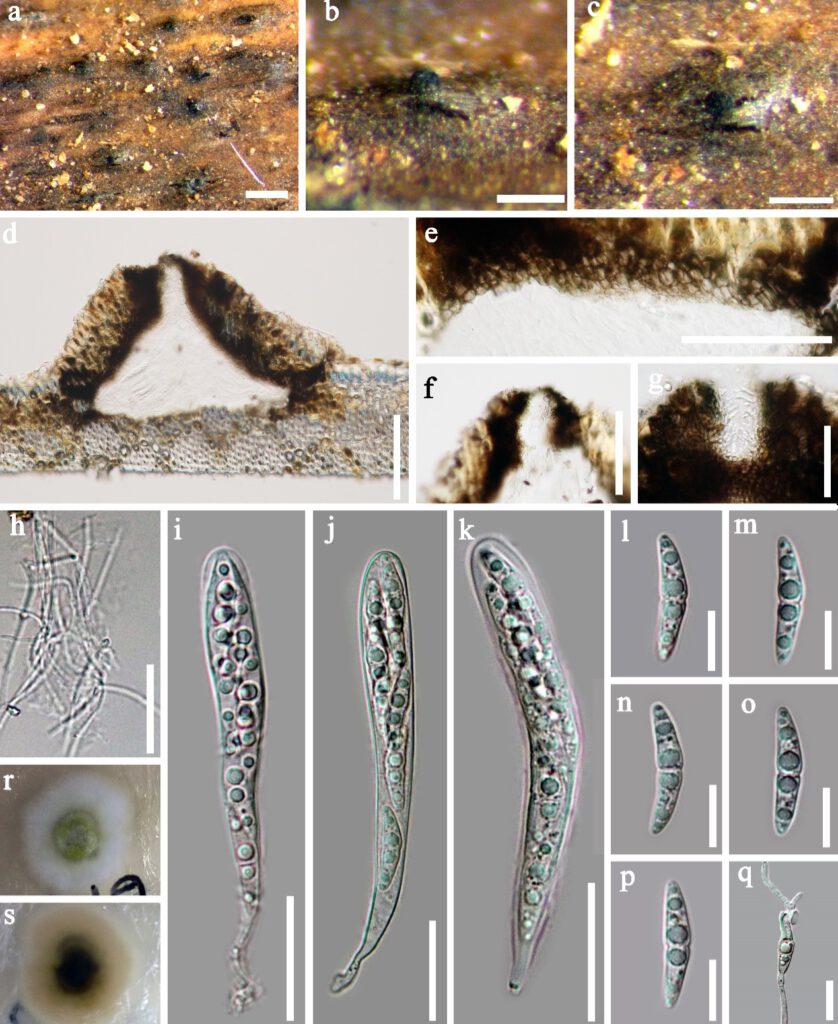Bambusicola bambusae D.Q. Dai & K.D. Hyde, Cryptog. Mycol. 33(3): 372 (2012)
MycoBank number: MB 801046; Index Fungorum number: IF 801046; Facesoffungi number: FoF 11797;
Saprobic on decaying wood in a freshwater stream. Ascomata 135–175 µm high × 190–245 µm diam. ( = 155 × 216 µm; n = 10), solitary, scattered to gregarious, immersed under the host tissue, conical in section, brown to dark brown, coriaceous, subglobose, ostiolate. Ostiole crest-like, central, elongated to papillate, with a pore-like opening, plugged by hyaline, filamentous hyphae. Peridium comprising host and fungal tissues,17–31 μm thick, composed of brown to dark brown cells of textura angularis intermingled with host cells. Hamathecium composed of numerous, filamentous, hyaline, septate, branched, 1.0–1.5 μm, pseudoparaphyses. Asci 55–75 × 7.5–9.5 μm ( = 66.3 × 8.5 μm, n = 20), 8-spored, bitunicate, fissitunicate, cylindrical, with a shallow apical chamber and a short furcate pedicel. Ascospores 19–21 × 4.0–4.5 μm ( = 20 × 4.5 μm, n =30), 2–3-seriate, 1-septate, constricted at the septum, slightly broad fusiform, tapering towards the ends, occasionally with large upper cell, with narrowly rounded ends, hyaline, guttulate, smooth-walled.
Culture characteristics: Ascospores germinating on PDA within 24 h and germ tubes produced from both ends. Colonies growing on PDA, reaching a diam. of 20–25 mm after 20 d at 25 °C, surface smooth to velvety, with entire to slightly undulate edge, greenish in the centre, white at the edge; reverse dark greenish to black in the centre, white at the edge.
Material examined: Thailand, Tao Ngoi, Sakon Nakhon, on decaying wood submerged in a river, 12 Nuvember 2017, D.F. Bao, B110 (MFLU 22–0080), living culture, MFLUCC 22–0021.

Fig. x Bambusicola bambusae (MFLU 21–xxxx, new record). a–c ascomata on wood d section of ascomae peridium, f, g ostiole. h pseudoparaphyses. i–k asci. l–p ascospores. q Germinating ascospore. r, s culture on PDA from surface and reverse. Scale bars: b, f = 100 μm, 5 = 50 μm, g = 30 μm, h–k = 20 μm, l–q = 10 μm
